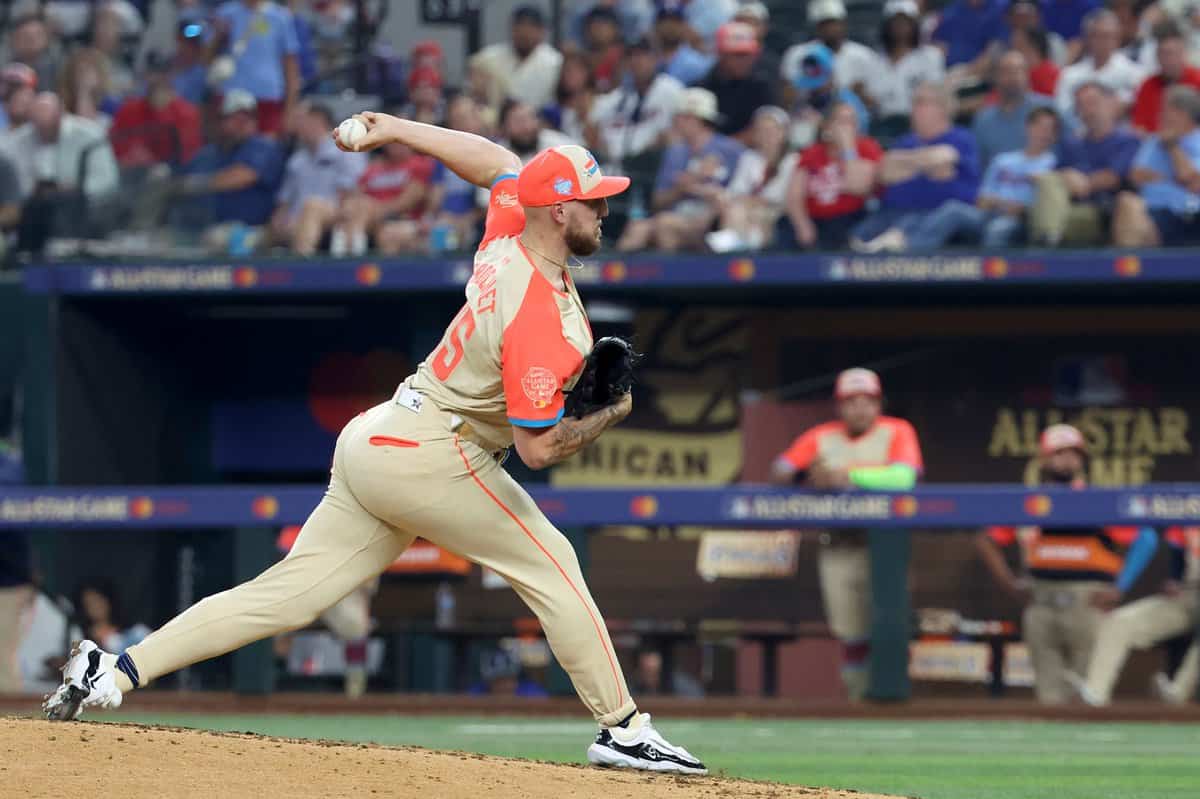Garrett Crochet loves talkin' ball. He's also likely to be traded for hitting in the offseason. So it seemed only right to take advantage of a player so willingly to talk about his process, and break down a sliver of his 2024 All-Star campaign.
Opinions differ.
"When you asked me, I thought, 'Yeah, that does sound really cool," Crochet said. "And then I thought, 'I don't know if I'm a good candidate for this.'
We'll leave that decision in the hands of Sox Machine readers.
This conversation has been heavily edited for clarity and length.
Crochet was asked to pick out his favorite inning of the season for us to break down together, and he contemplated a couple of options for a week before I wound up picking one for him: the bottom of the sixth in Seattle on June 13, as part of his career-high 13-strikeout outing.
Garrett Crochet: I still watch this game frequently.
James Fegan: Really?! How often?
GC: Probably once a week. More than I'm happy to admit on recording.
While belief in his potential to be an ace starter is something Crochet has always maintained to some degree, it had withered by spring 2023, when he was rehabbing from Tommy John surgery and showing what he felt was diminished stuff. It started cresting after he dominated the lauded Braves offense in his second start of 2024. But Crochet said in this outing in Seattle, where he dominated almost entirely with a fastball and cutter, he really believed he locked into exceptional fastball command, and the delivery cues that made it possible.
GC: "Get your fastball to your glove side" was a big cue for me at this point in the year. Throughout the year, that sort of thing changes just because your body adapts to find the most efficient route to a pitch. One month it may be to get your fastball to the glove side. Another month, and where I'm at right now, if I can drive my fastball up and away to my arm side, then everything is in tune. But at this point if I'm missing high, arm side, just drive it to the glove side and everything will be back.
Mostly, I was curious why he ever suggested an inning that opened with him issuing a four-pitch walk to former teammate Seby Zavala.
GC: This one to Seby hurt. He had crushed a foul ball in his first at-bat. Just knowing him as a teammate for so long, I definitely thought he was sitting on the cutter. In my mind, if I could paint the fastball up and away, then the cutter is going to be wide open. It's one of those spaces where you're trying to be too fine.
Yeah, there it is: four straight to start the inning.
...
The baseball saying is 'solo [HRs] don't beat you.' Once you get start getting afraid of the solos, now you're having the Seby Zavala leadoff walk. That's definitely what I was afraid of in that scenario. I want to say it was a cutter, it might have been a 2-1 fastball in his first at-bat, and he smoked it foul. So now that no one was on base, in my mind this guy's absolutely about to cut it loose. First pitch of the inning, he's about to come out G-hacking. He hasn't been playing much lately. Maybe he's got something to prove and wants to absolutely pump one off me. You get afraid of that and then you're walking guys with no outs. Leadoff walks typically score.
JF: So in conclusion, you were intimidated by Seby and he threw you off your game.
GC: [Laughs] If he's reading this, sure, let him think that.
Crochet's loud F-bomb after walking Zavala is clearly heard on the broadcast, prompting him to cackle again. Three months later, Crochet doesn't remember much about Korey Lee's mound visit other than that he was overly consumed with blanking the bottom of the Mariners order. That said, his game plan to leadoff man J.P. Crawford wasn't overly complex. You don't want to be thinking through too much out there.
GC: Just overpower him, to be honest. I overmatched him in the first at-bat ... I'm really just trying to overpower him. That's my approach with a lot of guys ... and those two just miss. That's tough.
This is contrast to a later portion of this at-bat where Crochet is mid-sentence, sees video of himself dotting a corner and interjects, "Ooh, gimme that."
JF: It's not a bad cutter to split the plate and be right under the zone. You would get a lot of chases, I would think.
GC: Right. This game I was randomly dotting the bottom of the zone and I don't know why. I don't know if my extension was up or what the deal was. But I remember to a lot of righties in this start I was pounding down and in, which is traditionally not a good route to go. But they were just taking it because they had to honor the cutter.
Right after this one is where we came here and faced Houston and they got nine hits, and I think two of them were [hit] over 90 mph. They were just able to fight off the fastballs up and in because they had a lot of righties, and I was just pounding fastballs up and in, and cutters up and in and they were able to get scrappy.
JF: And that triggered a change.
GC: This is probably a couple weeks into me figuring out that the fastball and cutter alone play extremely well. But then it was the following one against the Astros that I realized I needed to get the changeup a little bit more involved.
Ethan Katz comes out for a mound visit after the second straight walk, and starts up a conversation that Crochet said is mostly about the fastball command cues and the attack plan for the next hitter. The message of "please calm down and throw strikes" is more implied than plainly stated during these meetings, Crochet says.
GC: [He's] probably saying something along the lines of, "Don't try and strike everyone out here, just focus on this batter." And in my mind I'm thinking, "I'm going to focus on him, and strike him out."
GC: I'm pretty sure this is [Dylan Moore's] first game from injury or a paternity stint as well, so I was feeling really good with the same thing I was attempting to do but failed with Crawford. I was feeling good with overpowering him.
JF: Is that in the back of your mind, that this guy might not be on time [for the fastball] from the layoff, and just throw the heater until he proves that he's on it?
GC: I struck him out the first two times with heaters that were fairly middle of the plate.
[We watch as Moore swings through a middle-middle fastball for strike three]
GC: Yeah! Fairly middle! But in a two-strike count after just walking two guys, I'm not in a position where I can afford to get a chase out of the zone and get a weak ground ball, or a chase swing-and-miss. I'm trying to win in the zone.
JF: Do you regard that as a mistake, or do you see it as you executed the pitch -- it's 98 mph, it's got vert, it's effective?
GC: I was trying to throw a by-you fastball, and that's what it was.
The moments of simplicity within this game's complexity are always so beautiful.
JF: Obviously Julio [Rodríguez] is struggling this time of year, but he's still Julio.
GC: Yeah, I got one in on his hands and I think the first two at-bats he grounded out to second base. I'm feeling really good with the fastball-cutter combo. With a guy like him with long levers -- that's a check-swing that didn't get called and I had to throw a lot more pitches, but that's OK.
Rodríguez goes around on the 0-1 pitch to a comically obvious degree on a check-swing that doesn't get called, to the point where Rodríguez himself starts to walk back to the dugout on the actual strike two because he thinks the at-bat is over.
GC: With a guy like him with long limbs, my thought is don't let him get extended. Don't let him beat me out over the plate.
JF: It's a small thing, but is it hard to refocus after the blown call?
GC: Not really, [laughs] because I knew the count.
JF: If you knew that he thought it was 0-2, would you have thrown the same pitch?
GC: I don't know. I mean, I guess I did throw the same pitch. I kind of had set that cutter up with the two fastballs in, so to go back to it, I had just sped him up inside even more. So I don't think it would have beneficial to go to the same location.
Crochet slides almost to a knee on the finish of a pitch.
GC: Just a slip. Sometimes I get a little excited and I feel like I over-extend. It used to happen a lot with sliders.
Crochet is smacking super hard on his gum at this point of the inning. Reporters will occasionally sample the provided bubble gum in the dugout while waiting for the manager's pregame session and the flavor is ... not long-lasting.
JF: How many innings does a piece of gum survive?
GC: I usually will add to it every other inning. I start with two pieces to start the game. I'll probably add to it every other inning as it loses flavor.
JF: You got through seven innings, is it a huge mound in your mouth by the end?
GC: Probably. It's at like four or five pieces.
Crochet starts Mitch Garver off with a perfect top rail heater at 97 mph for a swing-and-miss to start the at-bat. He is clearly pleased.
GC: Man, these are the hits right here.
JF: After the two walks is there a little bit of eff-you energy, or even just a full head of steam because of the two strikeouts?
GC: A little bit. I kind of try and have that throughout the entire start, but oftentimes it takes getting pissed off to amp it back up.
Crochet doubled up on a high 97 mph fastball to Garver, which the Mariners catcher fouled back with a high popup.
JF: What's the line between "he fouled it off, maybe don't go back there again" or "he's still not on it, I can keep blowing him away"?
GC: Fouling it straight back on a four-seam ... for me, my four-seam isn't crazy ride, but because of my slot, I feel like the ride plays up a little bit more. But when you foul it straight back, that's the miss you're supposed to have. You either going to swing under it and swing-and-miss, or swing under it and foul it straight back. If you pull it foul, that's maybe where I'm trying to not go back to it.
JF: That's telling you they're sped up.
Crochet tries to paint the inside corner with two fastballs and a cutter, only for Garver to take all three and run the count full. In the meantime, I drop my recorder twice.
GC: He's a good control-the-zone guy.
JF: So what is that telling you, that ultimately you're going to have to challenge him?
GC: Now I'm just throwing it as hard as I can for a strike.
That's kind of who I've always been as a pitcher, just a power pitcher. Even when I threw 87 mph my senior year of high school, I was still a power pitcher in my mind.
Garver flies to the track in center on a fastball down-and-in, a spot which Crochet had earlier joked about hitting repeatedly, unintentionally. He said he didn't have to make a big case to get brought back out for the seventh inning, even though his starts began getting ratcheted down in length in a month's time.
The finish to this inning is appropriate, for as much as Crochet is lauded for strikeouts, he prides himself on being willing to challenge everyone in the strike zone. Crochet explains his belief that with any walk a pitcher allows, he can't be mad if the run scores, because big league hitters are too good to be granted unforced errors. So Crochet gets excited to throw fastballs by people like everyone else, but finds himself openly admiring the kitchen sink approach of Seth Lugo, who gives himself a bevy of options with which to attack the strike zone. That Crochet wants to marry the confidence he has with letting it rip at maximum effort with giving hitters a variety of looks, is how he wound up throwing sinkers at the end of the year, because it allowed to get the arm-side movement of a changeup without taking anything off.
That makes him look like a much different pitcher than he was on June 13, but Crochet finds himself coming back to this game because it was a big moment in him realizing that such an evolution was possible, if only because it showed how much command he could wield.
GC: I remember doing their scouting report and for a lot of guys it was down-and-away and up-and-in for the four-seam fastball. Since being in the major leagues, it's been "throw your four-seam up in the zone." But that goes along the lines of [being crafty]. It was like, "What if I can get it down in the zone?" And just get to that quadrant and stop guys from hunting middle-in. And I feel like in that game I did it really well as far as getting bottom, getting top, getting in, getting out, and yet still the cutter remained consistent inner rail and in-off.
That was a moment for me when I realized I could be an ace-caliber pitcher. Which, I always obviously believed in myself. But it was, what do I need to add to do better? But I guess what that outing told me is to stay on the path that I'm on.






